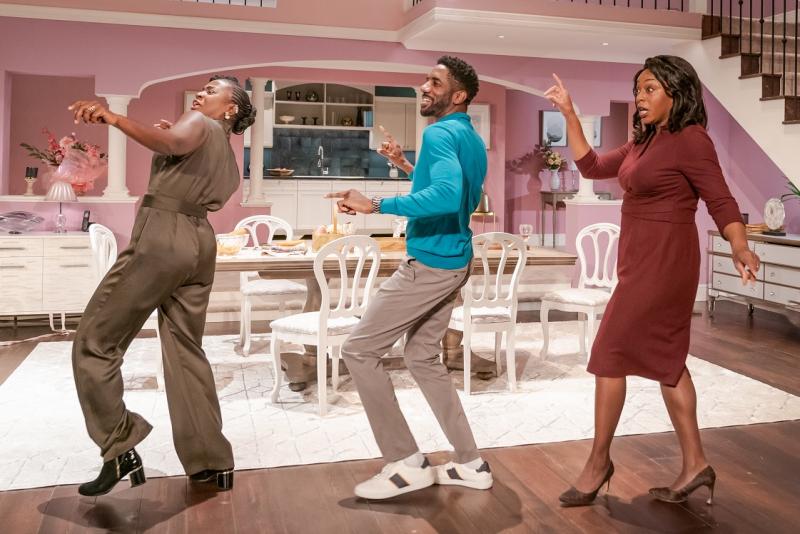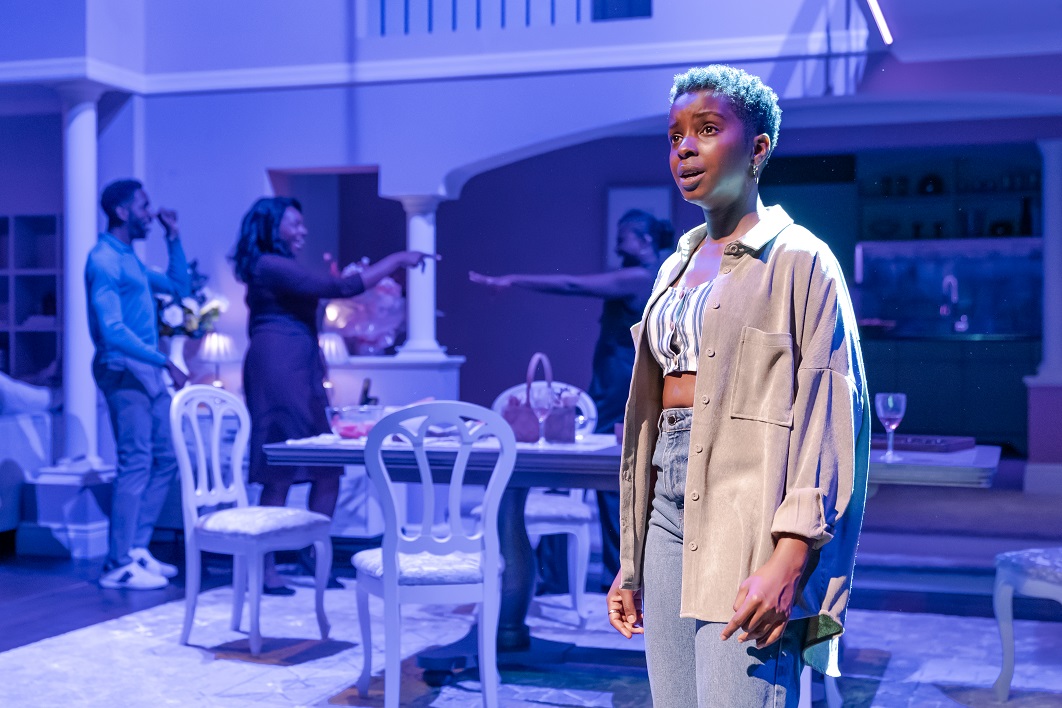Fairview, Young Vic review - questioning the assumptions of race | reviews, news & interviews
Fairview, Young Vic review - questioning the assumptions of race
Fairview, Young Vic review - questioning the assumptions of race
New American drama directs a rapier wit at black stereotypes

Jackie Sibblies Drury’s Fairview comes to the Young Vic with the 2019 Pulitzer Prize for Drama under its belt, and a reputation for putting audiences on their mettle through a build-up of theatrical sur
The result is ingenious in every way, a self-referential consideration of that driving issue of American drama, and society itself – race. The standard theatrical expectations of a conventional comedy first act – a family drama that proceeds along traditional lines of preparations for an anniversary gathering – are literally pulled away from under the audience’s feet as Sibblies Drury exposes the assumptions that lie behind the form. She has clearly absorbed all the stereotypes, drawn principally from television, the sitcom especially, of representation of black family life to cut away at them with a rapier-like wit, one that unnerves in its manipulation of “meta” allusions far more than it makes us laugh in any conventional sense (though it does that, too).
It’s as if they are re-enacting their own drama, this time as marionettes
Designer Tom Sutt offers a plush living-room set, all soft colours, artfully arranged cushions and vases of flowers, that clearly indicates prosperity. Beverly (Nicola Hughes) is preparing for her mother’s birthday celebration, while husband Dayton (Rhashan Stone) helps out – though the joshing dynamics of their relationship means that on occasions he’s almost teasing her, possibly to calm her nerves: Beverly certainly seems to have left preparations rather to the last minute.
The ring of the doorbell makes that tardiness clear, heralding the arrival of Beverly’s sister Jasmine (Naana Agyei-Ampadu). Dayton seems rather nonplussed that she’s been asked at all, since Jasmine obviously has a way of getting under her sibling’s skin, as the scene that follows shows: Jasmine strutts the stage in a way that articulates her self-centredness, displaying a knack for finding just the phrase or gesture guaranteed to niggle her target. It’s a sister-to-sister stand-off that Sibblies Drury writes very well in a set-piece sort of way, just as she has earlier given Beverly some very long speeches in her banter with her husband. The final (official, at least) arrival on the scene is teenage Keisha (Donna Banya, playing with a confidence that goes beyond her years), who’s clearly close to her aunt, and not above manipulating an already fraught family dynamic for her own ends. So far, we think, so conventional. Very conventional indeed, in fact, until the realisation kicks in that Sibblies Drury has been treating her setting with far more of an element of ironic hyper-realism than any more conventional version of that form. We’re forced to question how we expect an affluent black American family to behave, how much their world is drawn from established representations, right down to the family dance numbers (main picture). Indeed, what do we expect of an affluent black American family, when the portrayal of black identity seems defined by the equation articulated later in the play that “real black equals poor black”? (The exceptions, from the worlds of sports or music, prove that rule.)
So far, we think, so conventional. Very conventional indeed, in fact, until the realisation kicks in that Sibblies Drury has been treating her setting with far more of an element of ironic hyper-realism than any more conventional version of that form. We’re forced to question how we expect an affluent black American family to behave, how much their world is drawn from established representations, right down to the family dance numbers (main picture). Indeed, what do we expect of an affluent black American family, when the portrayal of black identity seems defined by the equation articulated later in the play that “real black equals poor black”? (The exceptions, from the worlds of sports or music, prove that rule.)
The unexpected turn that Act II takes brings such issues into the open. To maintain any element of surprise, it’s enough to say that we witness an observational commentary that gives an entirely new context to what we have just seen. As that initial action is reprised, almost in fast-forward, a different set of voices, derived from a very different world, starts up; the skill, almost of mime, of the opening quartet is considerable, one particular effect – by which they seem on occasions to be articulating that over-voice text as their own – being especially striking. It’s as if they are re-enacting their own drama, this time as marionettes, a manipulation crucially accented by our presumption of who exactly is doing the manipulating.
Sibblies Drury’s ambitiously referential text merits being considered alongside another recent work of black American drama, Branden Jacobs-Jenkins's An Octoroon. That work used the device of melodrama to convey its message, and both playwrights prove extremely agile in their wit: they catch us up in the ingenuity of their dramatic structures, which in some ways threaten to dwarf the human experiences that we see on stage.
That’s a qualification that Fairview answers resoundingly in its final act, however, the combination of varying registers handled by director Nadia Latif with aplomb throughout. Donna Banya’s Keisha (pictured above) delivers closing duties with all the bravado of one of Dickens’s urgent protagonists tugging at society's heart-strings as they appeal for an adjustment in the way the world works. It's a rollicking breaking of the fourth wall that evinces an empathy all the more powerful for the artifice that has come before.
rating
Share this article
The future of Arts Journalism
You can stop theartsdesk.com closing!
We urgently need financing to survive. Our fundraising drive has thus far raised £49,000 but we need to reach £100,000 or we will be forced to close. Please contribute here: https://gofund.me/c3f6033d
And if you can forward this information to anyone who might assist, we’d be grateful.

Subscribe to theartsdesk.com
Thank you for continuing to read our work on theartsdesk.com. For unlimited access to every article in its entirety, including our archive of more than 15,000 pieces, we're asking for £5 per month or £40 per year. We feel it's a very good deal, and hope you do too.
To take a subscription now simply click here.
And if you're looking for that extra gift for a friend or family member, why not treat them to a theartsdesk.com gift subscription?
more Theatre
 Othello, Theatre Royal, Haymarket review - a surprising mix of stateliness and ironic humour
David Harewood and Toby Jones at odds
Othello, Theatre Royal, Haymarket review - a surprising mix of stateliness and ironic humour
David Harewood and Toby Jones at odds
 Macbeth, RSC, Stratford review - Glaswegian gangs and ghoulies prove gripping
Sam Heughan's Macbeth cannot quite find a home in a mobster pub
Macbeth, RSC, Stratford review - Glaswegian gangs and ghoulies prove gripping
Sam Heughan's Macbeth cannot quite find a home in a mobster pub
 The Line of Beauty, Almeida Theatre review - the 80s revisited in theatrically ravishing form
Alan Hollinghurst novel is cunningly filleted, very finely acted
The Line of Beauty, Almeida Theatre review - the 80s revisited in theatrically ravishing form
Alan Hollinghurst novel is cunningly filleted, very finely acted
 Wendy & Peter Pan, Barbican Theatre review - mixed bag of panto and comic play, turned up to 11
The RSC adaptation is aimed at children, though all will thrill to its spectacle
Wendy & Peter Pan, Barbican Theatre review - mixed bag of panto and comic play, turned up to 11
The RSC adaptation is aimed at children, though all will thrill to its spectacle
 Hedda, Orange Tree Theatre review - a monument reimagined, perhaps even improved
Scandinavian masterpiece transplanted into a London reeling from the ravages of war
Hedda, Orange Tree Theatre review - a monument reimagined, perhaps even improved
Scandinavian masterpiece transplanted into a London reeling from the ravages of war
 The Assembled Parties, Hampstead review - a rarity, a well-made play delivered straight
Witty but poignant tribute to the strength of family ties as all around disintegrates
The Assembled Parties, Hampstead review - a rarity, a well-made play delivered straight
Witty but poignant tribute to the strength of family ties as all around disintegrates
 Mary Page Marlowe, Old Vic review - a starry portrait of a splintered life
Tracy Letts's Off Broadway play makes a shimmeringly powerful London debut
Mary Page Marlowe, Old Vic review - a starry portrait of a splintered life
Tracy Letts's Off Broadway play makes a shimmeringly powerful London debut
 Little Brother, Soho Theatre review - light, bright but emotionally true
This Verity Bargate Award-winning dramedy is entertaining as well as thought provoking
Little Brother, Soho Theatre review - light, bright but emotionally true
This Verity Bargate Award-winning dramedy is entertaining as well as thought provoking
 The Unbelievers, Royal Court Theatre - grimly compelling, powerfully performed
Nick Payne's new play is amongst his best
The Unbelievers, Royal Court Theatre - grimly compelling, powerfully performed
Nick Payne's new play is amongst his best
 The Maids, Donmar Warehouse review - vibrant cast lost in a spectacular-looking fever dream
Kip Williams revises Genet, with little gained in the update except eye-popping visuals
The Maids, Donmar Warehouse review - vibrant cast lost in a spectacular-looking fever dream
Kip Williams revises Genet, with little gained in the update except eye-popping visuals
 Ragdoll, Jermyn Street Theatre review - compelling and emotionally truthful
Katherine Moar returns with a Patty Hearst-inspired follow up to her debut hit 'Farm Hall'
Ragdoll, Jermyn Street Theatre review - compelling and emotionally truthful
Katherine Moar returns with a Patty Hearst-inspired follow up to her debut hit 'Farm Hall'
 Troilus and Cressida, Globe Theatre review - a 'problem play' with added problems
Raucous and carnivalesque, but also ugly and incomprehensible
Troilus and Cressida, Globe Theatre review - a 'problem play' with added problems
Raucous and carnivalesque, but also ugly and incomprehensible

Add comment